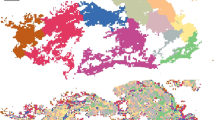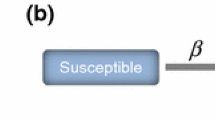Abstract
Space adds an additional axis to the richness of infectious disease dynamics. For example, Gog et al. (2014) detailed the diffusive nature of the spread of influenza A/H1N1pdv and Lau et al. (2017) characterized the geographic spread of the West African 2014–2015 Ebola outbreak. Walsh et al. (2005) calculated that Ebola was spreading through gorilla and chimpanzee populations at 50 km/year. Moreover, Grenfell and Harwood (1997) and Keeling et al. (2004) outlined how spatial spread may permit long-term persistence through metapopulation dynamics.
This chapter uses the following R packages: ncf, animation and plotly.
A five minute epidemics MOOC on spatial spread is: https://www.youtube.com/watch?v=WPjsAdyD1Gg
Access this chapter
Tax calculation will be finalised at checkout
Purchases are for personal use only
Similar content being viewed by others
Notes
- 1.
As discussed in Sect. 9.4 these two models are not nested in the sense that one model is a simpler version of the other so formal likelihood ratio test does not apply.
- 2.
- 3.
- 4.
The name refers to how the most stylized of these models assumes a lattice (checker board) of locations at which local numbers change from one generation to the next according to some “map**” rule of onward local change such as the discrete logistic, the Nicholson-Baily model (see Chap. 16) or, in this case, a discrete-time seasonally forced SI model, followed by spatial redistribution via some spatial coupling rule.
- 5.
The system() function in R passes the convert and rm calls to the command line. A web-optimized version of the animated GIF can be viewed on https://git.io/JMnHk. While not using base R syntax the plotly package is very effective for generating browser-rendered animations. An example can be found in the nbspat.app shinyApp in Chap. 16.
- 6.
Seabloom et al. (2005) provide similar calculations for spatial plant competition models.
- 7.
- 8.
References
Abbott, K. C., & Dwyer, G. (2008). Using mechanistic models to understand synchrony in forest insect populations: the North American gypsy moth as a case study. The American Naturalist, 172(5), 613–624.
Bascompte, J., & Solé, R. V. (1995). Rethinking complexity: Modelling spatiotemporal dynamics in ecology. Trends in Ecology and Evolution, 10(9), 361–366.
Bjørnstad, O. N., & Bascompte, J. (2001). Synchrony and second-order spatial correlation in host-parasitoid systems. Journal of Animal Ecology, 70(6), 924–933.
Bjørnstad, O. N., & Bolker, B. (2000). Canonical functions for dispersal-induced synchrony. Proceedings of the Royal Society of London B, 267(1454), 1787–1794.
Bjørnstad, O. N., Finkenstadt, B. F., & Grenfell, B. T. (2002a). Dynamics of measles epidemics: Estimating scaling of transmission rates using a time series sir model. Ecological Monographs, 72(2), 169–184.
Bjørnstad, O. N., Ims, R. A., & Lambin, X. (1999b). Spatial population dynamics: Analyzing patterns and processes of population synchrony. Trends in Ecology and Evolution, 14(11), 427–432.
Bjørnstad, O. N., Peltonen, M., Liebhold, A. M., & Baltensweiler, W. (2002b). Waves of larch budmoth outbreaks in the European Alps. Science, 298(5595), 1020–1023.
Bjørnstad, O. N., Robinet, C., & Liebhold, A. M. (2010). Geographic variation in North American gypsy moth cycles: Subharmonics, generalist predators, and spatial coupling. Ecology, 91(1), 106–118.
Broadbent, S., & Kendall, D. G. (1953). The random walk of Trichostrongylus retortaeformis. Biometrics, 9(4), 460–466.
Clark, D. A., & Clark, D. B. (1984). Spacing dynamics of a tropical rain forest tree: Evaluation of the Janzen-Connell model. The American Naturalist, 124(6), 769–788.
Clark, J. S. (1998). Why trees migrate so fast: Confronting theory with dispersal biology and the paleorecord. The American Naturalist, 152(2), 204–224.
Connell, J. H. (1971). On the role of natural enemies in preventing competitive exclusion in some marine animals and in rain forest trees. In Boer, P. J. D., & Gradwell, G., editors, Dynamics of populations (pp. 298–312). Wageningen: Centre for Agricultural Publishing and Documentation.
Cummings, D. A. T., Irizarry, R. A., Huang, N. E., Endy, T. P., Nisalak, A., Ungchusak, K., & Burke, D. S. (2004). Travelling waves in the occurrence of dengue haemorrhagic fever in Thailand. Nature, 427(6972), 344–347.
Dwyer, G., Dushoff, J., Elkinton, J. S., & Levin, S. A. (2000). Pathogen-driven outbreaks in forest defoliators revisited: Building models from experimental data. The American Naturalist, 156(2), 105–120.
Dwyer, G., Dushoff, J., & Yee, S. H. (2004). The combined effects of pathogens and predators on insect outbreaks. Nature, 430(6997), 341–345.
Earn, D. J. D., Levin, S. A., & Rohani, P. (2000a). Coherence and conservation. Science, 290(5495), 1360–1364.
Elkinton, J. S., & Liebhold, A. M. (1990). Population dynamics of gypsy moth in North America. Annual review of Entomology, 35(1), 571–596.
Erlander, S., & Stewart, N. F. (1990). The gravity model in transportation analysis: Theory and extensions (vol. 3). VSP.
Ferrari, M. J., Bjørnstad, O. N., Partain, J. L., & Antonovics, J. (2006b). A gravity model for the spread of a pollinator-borne plant pathogen. The American Naturalist, 168(3), 294–303.
Fotheringham, A. S. (1984). Spatial flows and spatial patterns. Environment and Planning A, 16(4), 529–543.
Gog, J. R., Ballesteros, S., Viboud, C., Simonsen, L., Bjornstad, O. N., Shaman, J., Chao, D. L., Khan, F., & Grenfell, B. T. (2014). Spatial transmission of 2009 pandemic influenza in the US. PLoS Computational Biology, 10(6), e1003635.
Grenfell, B., & Harwood, J. (1997). (meta)population dynamics of infectious diseases. Trends in Ecology and Evolution, 12(10), 395–399.
Grenfell, B. T., Bjørnstad, O. N., & Kappey, J. (2001). Travelling waves and spatial hierarchies in measles epidemics. Nature, 414(6865), 716–723.
Hanski, I. (1994). A practical model of metapopulation dynamics. Journal of Animal Ecology, 63(1), 151–162.
Hardin, G. (1960). The competitive exclusion principle. Science, 131(3409), 1292–1297.
Hassell, M. P., Comins, H. N., & May, R. M. (1991). Spatial structure and chaos in insect population dynamics. Nature, 353(6341), 255–258.
Janzen, D. H. (1970). Herbivores and the number of tree species in tropical forests. The American Naturalist, 104(940), 501–528.
Kaneko, K. (1993). Theory and applications of coupled map lattices. John Wiley and Son.
Keeling, M. J., Bjørnstad, O. N., & Grenfell, B. T. (2004). Metapopulation dynamics of infectious diseases. In Hanski, I., & Gaggiotti, O., (Eds.), Ecology, Genetics, and Evolution of Metapopulations (pp. 415–445). Elsevier.
Keeling, M. J., & Rohani, P. (2002). Estimating spatial coupling in epidemiological systems: A mechanistic approach. Ecology Letters, 5(1), 20–29.
Keeling, M. J., Wilson, H., & Pacala, S. W. (2002). Deterministic limits to stochastic spatial models of natural enemies. The American Naturalist, 159(1), 57–80.
Kot, M., Lewis, M. A., & van den Driessche, P. (1996). Dispersal data and the spread of invading organisms. Ecology, 77(7), 2027–2042.
Lau, M. S. Y., Dalziel, B. D., Funk, S., McClelland, A., Tiffany, A., Riley, S., Metcalf, C. J. E., & Grenfell, B. T. (2017). Spatial and temporal dynamics of superspreading events in the 2014–2015 West Africa Ebola epidemic. Proceedings of the National Academy of Sciences, 114(9), 2337–2342.
Mari, L., Bertuzzo, E., Righetto, L., Casagrandi, R., Gatto, M., Rodriguez-Iturbe, I., & Rinaldo, A. (2012). Modelling cholera epidemics: The role of waterways, human mobility and sanitation. Journal of the Royal Society Interface, 9(67), 376–388.
Mollison, D. (1991). Dependence of epidemic and population velocities on basic parameters. Mathematical Biosciences, 107(2), 255–287.
Petermann, J. S., Fergus, A. J., Turnbull, L. A., & Schmid, B. (2008). Janzen-Connell effects are widespread and strong enough to maintain diversity in grasslands. Ecology, 89(9), 2399–2406.
Seabloom, E. W., Bjørnstad, O. N., Bolker, B. M., & Reichman, O. J. (2005). Spatial signature of environmental heterogeneity, dispersal, and competition in successional grasslands. Ecological Monographs, 75(2), 199–214.
Smith, D. L., Ericson, L., & Burdon, J. J. (2003). Epidemiological patterns at multiple spatial scales: an 11-year study of a Triphragmium ulmariae–Filipendula ulmaria metapopulation. Journal of Ecology, 91(5), 890–903.
Smith, D. L., Lucey, B., Waller, L. A., Childs, J. E., & Real, L. A. (2002a). Predicting the spatial dynamics of rabies epidemics on heterogeneous landscapes. Proceedings of the National Academy of Sciences, 99(6), 3668–3672.
Tilman, D. (1976). Ecological competition between algae: Experimental confirmation of resource-based competition theory. Science, 192, 463–465.
Truscott, J., & Ferguson, N. M. (2012). Evaluating the adequacy of gravity models as a description of human mobility for epidemic modelling. PLoS Computational Biology, 8(10), e1002699.
Turing, A. M. (1990). The chemical basis of morphogenesis. Bulletin of Mathematical Biology, 52(1), 153–197.
Viboud, C., Bjørnstad, O. N., Smith, D. L., Simonsen, L., Miller, M. A., & Grenfell, B. T. (2006). Synchrony, waves, and spatial hierarchies in the spread of influenza. Science, 312(5772), 447–451.
Walsh, P. D., Biek, R., & Real, L. A. (2005). Wave-like spread of Ebola Zaire. PLoS Biology, 3(11), e371.
**a, Y., Bjørnstad, O. N., & Grenfell, B. T. (2004). Measles metapopulation dynamics: A gravity model for epidemiological coupling and dynamics. The American Naturalist, 164(2), 267–281.
Author information
Authors and Affiliations
Rights and permissions
Copyright information
© 2023 The Author(s), under exclusive license to Springer Nature Switzerland AG
About this chapter
Cite this chapter
Bjørnstad, O. (2023). Spatial Dynamics. In: Epidemics. Use R!. Springer, Cham. https://doi.org/10.1007/978-3-031-12056-5_12
Download citation
DOI: https://doi.org/10.1007/978-3-031-12056-5_12
Published:
Publisher Name: Springer, Cham
Print ISBN: 978-3-031-12055-8
Online ISBN: 978-3-031-12056-5
eBook Packages: Mathematics and StatisticsMathematics and Statistics (R0)




